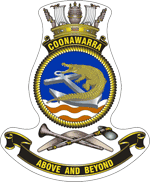HMAS Coonawarra (naval base)
| HMAS Coonawarra | |
|---|---|
| Darwin, Northern Territory in Australia | |

Ship's badge of HMAS Coonawarra
|
|
|
Location in the Northern Territory
|
|
| Coordinates | 12°27′31″S 130°49′18″E / 12.45861°S 130.82167°ECoordinates: 12°27′31″S 130°49′18″E / 12.45861°S 130.82167°E |
| Type | Naval base |
| Site information | |
| Owner | Department of Defence |
| Operator |
|
| Website | navy |
| Site history | |
| Built | 1940 |
| In use | 1935 – current |
| Garrison information | |
| Current commander |
Commander Viktor Pilicic, RAN |
HMAS Coonawarra is a Royal Australian Navy (RAN) base located in Darwin, Northern Territory and is home to twelve fleet units of the RAN. The current commender is Commander Viktor Pilicic, RAN.
During World War I, Port Darwin had been used as a coaling station for naval ships, but it was not considered a naval base. Later, during the 1930s, the RAN constructed oil fuel tanks on the harbour front, holding about 82,000 tonnes (90,000 short tons) of oil. All were destroyed in the Japanese attack on Darwin on 19 February 1942.
The first naval depot at Darwin was established in January 1935. This was a naval reserve depot, commanded by Lieutenant Commander H.P. Jarrett. At this time, Darwin was part of the Naval Reserve District of Queensland. In 1937, the Naval District of the Northern Territory was separated from the Queensland District, and the first District Naval Officer, Lieutenant Commander J.H. Walker, was appointed. In 1939, under the recommendation of the Committee of Imperial Defence, a high-powered radio transmitter was constructed. The period leading up to World War II saw a buildup of personnel, the establishment of fuelling facilities, a boom depot and later the Navy paid for improvements to Darwin's water supply in order to provide an adequate supply of water for visiting naval ships.
At the outbreak of World War II, the Naval depot in Darwin was named HMAS Penguin, and on 1 August 1940 was formally commissioned as HMAS Melville. Throughout World War II, the Wireless Transmitting Station provided essential communications service in support of Allied Operations in the South West Pacific regions. The base suffered significant damage during the Japanese bombing raids on the city.
After World War II, the base continued to be known as HMAS Melville. The development of Darwin during the 1950s and 1960s saw the size of Melville shrink, the problem was intensified by the continued growth of naval personnel in Darwin. It was decided to decommission Melville and relocate the RAN's Darwin base to naval Wireless Transmitting Station Coonawarra. Although the base was transferred over and commissioned at HMAS Coonawarra on 16 March 1970, facilities at Melville remained operational until their destruction by Cyclone Tracy on 25 December 1974.
...
Wikipedia

